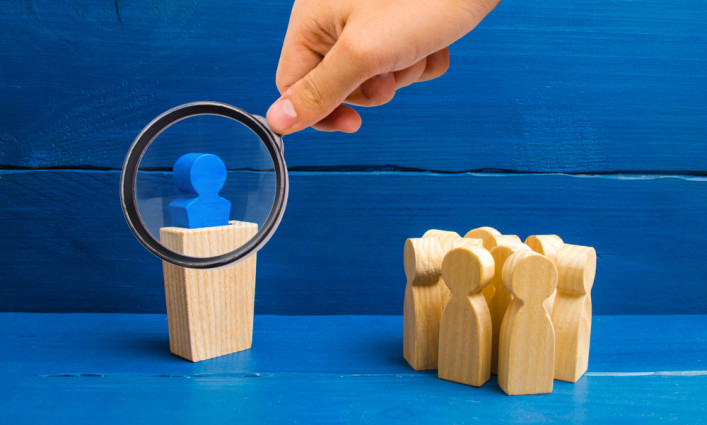I promised some further thoughts on making the presentation process more comfortable: it seems to me that (in general) the more comfortable the speaker, the better the experience for the listener. And for most of us, the key to a comfortable delivery is being sufficiently organized to reduce uncertainty to a comfortable minimum.
Companions in adversity

D'Artagnan and The Three Musketeers - "Athos, Aramis, and Porthos"
Image: The Three Musketeers by Alexandre Dumas (illustration of the Appleton edition) via Wikipedia
It's a bit of a cheat, but consider with gratitude offers to co-present, or even presentation by proxy (though having someone else speak for you is quite stressful for control freaks [i]). Bear in mind, though, that a presentation with more than one presenter does increase uncertainty, especially if your co-presenters are based in geographically far-flung locations, and there's little or no time for a practice run before the real thing. At the very least, you need to make sure that:
- All the presenters know how much time is allocated to their individual segments
- Someone is unequivocally responsible for providing the device from which the slide deck is run. And maybe the Designated Driver who'll actually change the slides (and even keep an eye on the time).
Though it doesn't hurt to have someone else carrying a device that also contains the slide deck as a backup.
Be prepared! Be very, very prepared!
The better organized your presentation is, the fewer variables there are to throw you into the mire on the day. You may not feel less harassed with a fully prepared presentation in your luggage, but trust me, if you do fall into the sort of booby trap that catches the unprepared, you will feel worse. On the plane is not the best time and place to finish off a presentation, or to rehearse your timing. Nor, come to that, is sitting jetlagged in your hotel room the night before.
Practice, Practice, Practice. Even those brave and talented souls who apparently deliver speeches with no memory aids but (maybe) a few slides do this: in fact, that's exactly how (in most cases) they're able to do it. Clearly, unless you're exceptionally gifted at verbal improvisation, this is essential in terms of getting your timing right. But there's nothing like actually speaking the presentation aloud to highlight typos and issues like sentences that are too long and/or complicated. (It's not a bad idea to do that with articles and papers, too.) Doing a dry run with some other victim person in the room will help you spot points that are crystal clear to you, but less so to others. It's probably as well to make it someone who's going to be kind, but honest. Some people find it useful to record their run through, but be aware that if you've never heard a recording of yourself speaking, you may find it rather a shock. (Hearing yourself singing as others hear you is even weirder, but we won't get further into that on this occasion.) You'll almost certainly spot rough patches that won't be obvious to anyone else, but that gives you the chance to sand them down. Some of the larger conferences offer preparation and coaching for speakers: if this is the case at an event you're speaking at, it's well worth considering taking advantage of the offer. Not least because it will give you an idea of what audiences at that particular event will expect from you.
Prepare a handout: even if you’re not able to get it distributed[ii], it will help no end in establishing exactly what points it is you want to make, and you may want to make it available online before or after the presentation. You might even want to use it as the basis for the slide deck.
Who knows where the time goes?
Timing is important (even more so if you're co-presenting). I put the expected timing of the current slide and the cumulative timing (how far through I should be at this point in the presentation) onto my speaker's notes. If you're one of those people who no longer wear wristwatches because they have mobile phones, you need to make sure that you have an alternative, such as a stopwatch app. An elapsed time counter is available from PowerPoint's multi-screen 'Presenter' view, but you'll definitely want to try this out ahead of time with a second screen attached to your laptop. Nick FitzGerald tells me that most large events now have a large LCD TV timer screens in front of the stage that usually change colour when you’re in the last five minutes of the time slot. This sounds useful, but remember that you probably need to take into account time for questions as well as the end of the slot.
"Unless you have psychic powers, you probably can’t forestall everything that might go wrong"
Just before you go on is not the best time to wonder which key combination sets up your laptop for projector output, or to realize that you need an unusual video cable. If you're using a less conventional mobile device, that goes double. A laptop with a simple VGA connector will probably get along with any projector, and nowadays there are converters for a wide range of devices and ports that may well give you the same basic connectivity. However, individual types of projector and computing device may offer a plethora of other possibilities to transfer more than video. For example, recent laptops tend to have an HDMI port as well as or instead of VGA. However, if you don't know what sort of projector you're going to be connecting to (and your presentation is just video), maybe see whether there's a converter for your device which will give you basic VGA. For instance, I have an adapter for a Surface Mini DisplayPort that does this, though I've never had to use it. N.B. This is not an area in which I claim any expertise or product knowledge, so I'm afraid you'll have to do your own research!
I'd strongly recommend keeping a copy of the presentation on one or more USB devices (I like to carry at least two). In that way, not only do you have a safety net, you may even find that all you need to do is load your presentation onto a laptop belonging to or rented by the conference organizers.
Hopefully, you will never find yourself in the situation where you get to the venue, only to discover that there isn't a projector of any sort in the room that's been assigned to you. I've found myself in this situation twice. The first was at a job interview: fortunately, it was a short presentation and I had enough handouts for everyone on the interview panel. The second was at one of the "Lunch and Learn" sessions on security I did while working for the UK's National Health Service. That presentation was meant to run for two hours (yes, torture for everyone concerned…), and I didn't have handouts. Some will handle this perfectly happily on a wing and a prayer. Me? I was just grateful for hardcopy notes, and the fact that those notes weren't over-reliant on visual effects. Fortunately, a total absence of audio-visual projection isn't usually an issue at a conference today, even when you find yourself in a broom cupboard with an audience of two while everyone else is in a large hall listening to Bruce Schneier.
Travelling hopefully
One version of Murphy’s Law states that "Anything that can go wrong will go wrong, and at the worst possible moment". This may sound unduly pessimistic, but it's worth keeping it in mind in any situation involving a risk of public embarrassment. Sadly, making a public presentation is one of those situations.
Unless you have psychic powers, you probably can’t forestall everything that might go wrong. But let me take you back to the mid-90s, when I first started to make conference presentations. At my very first, it turned out that there was no way my laptop was going to work with the available projector: fortunately, I was able to transfer the presentation to a laptop kept in reserve by the conference organizers. This isn't always the case, especially with huge conferences running multiple tracks simultaneously.
On this occasion, I thought I'd learned my lesson. So when I flew out to present at a SANS conference three weeks later, I had hard copy, a CD copy, and back-up transparency slides[iii]. They were in my suitcase, which the airline duly unloaded at Dulles and forwarded to Chicago. Unfortunately, the conference was in New Orleans. Happily, the suitcase got to me before my presentation. In any case, I still had the laptop (with softcopy of the presenter's notes), and this time the VGA link worked. Nevertheless, ever since that trip to New Orleans, my conference materials have travelled in my hand luggage. After all, the more you fly, the more frequently you're likely to be unintentionally parted from your luggage at some point. I've been fairly lucky in that respect: the airlines concerned have always managed to reunite me with my checked baggage within a day or so. Other presenters have been less fortunate.
Setting up
Think about how you're going to dress (preferably well before the presentation!). You don't necessarily need to be a model of High Street fashion, but you don't usually want people to be thinking about what you look like instead of what you're saying, especially if those thoughts are unflattering. Don't slouch. Smile and say hello: at least try to give the impression that you want to be there and are looking forward to delivering your message, rather than wondering how soon the bar will be open.
If yours is not the first presentation in the session, it's unlikely that you'll be required to be sitting on the platform for the presentation(s) preceding. Even if yours is the first, however, it takes a little pressure off if you can sit somewhere off the platform until the session chair is ready to announce you. First impressions are important. (So try not to trip as you approach the microphone…)
It's likely that you will need to have something sitting on screen while the audience trickles in (and out). That may be the most important slide of your whole presentation: make it something that will attract (or at least not alienate) people from the moment they see it. That might even distract them from the sight of you sitting there chewing your nails with an expression of terror on your face.
One way of saving time during setup is to have your presentation materials in a folder on the desktop: it’s quicker and easier to find there rather than buried somewhere deep in a folder called C:\...\mydocuments\mywork\virus-stuff\topics\presentations\BlackHat\2027_if_I_actually_get_to_the_conference_without_having_a_nervous_breakdown\. And you may not want a password-protected screensaver to kick in after two minutes of inactivity while running off battery. Even an audience of security mavens may start to lose patience after it happens two or three times. You may be able to circumvent these issues by switching to a 'presentation mode' power scheme, depending on your operating system version. This will probably be less of an issue if you can run off mains power during the presentation, as is often the case. This does, however, assume that you remembered to bring a suitable power plug adaptor to the presentation. It certainly won't do any harm to make sure your battery is fully charged beforehand, just in case.
If your system is set up with military-grade disk encryption and other security that causes it to take 20 minutes to boot, and there’s no way of bypassing it, five minutes before you’re due on is not a good time to power up. And I can tell you from bitter experience that if you have to follow someone with that particular problem, it can make a real mess of your timing. Which leads us on to the next point.
Be considerate!
Be particularly considerate to other presenters. Don't hog all the set-up time when there are others making presentations in the same session.
Obviously, don't overrun even if the person chairing the session seems [iv] willing to let you. (The members of your audience will also appreciate it if you don't force them to be at the end of the queue for coffee or for lunch, earning you brownie points on the [v] evaluation sheet.) Try to keep an eye on the session chair and/or the person at the back of the room whose job is to hold up a placard towards the end of the session telling you how many minutes you have left. It doesn't improve the quality of the presentation if the chair is desperately trying to attract your attention.
It's generally better to be under your allotted time than over it. Still, you may feel the need to have more material than you need. While this puts you at risk of shuffling pieces of paper while you decide on the fly what to leave out, it gives you something to come back to if you misjudge your timing. If your timing is that far out, you probably need to speed up or slow down, though, rather than getting into a tangle by trying to add or eliminate material. Something that works for me is to have optional material in a different font in my speaker notes. But that optional material is there in case someone wants me to expand on a particular point in the Q&A session immediately after the presentation, rather than with a view to filling the whole slot in the hope of avoiding awkward questions. I try to be merciful and not prolong the agony. For the audience or myself. And yes, you need to time the optional bits, too.
Ah, yes. Questions. What if a well-known researcher is in the front row and raises a topic he knows more about than you do?[vi] Despite that unquantifiable risk, I actually find that this is the part of the presentation that causes me least grief. You can’t do much to prepare for a question that hasn’t been asked, and in any case the worst part of the session is over.
- Presumably you are well acquainted with the topic on which you're presenting – that's why you were invited to present it.
- You might learn something from the person asking the question.
- You might even get a question that inspires you.
It can be useful to have a copy of the paper handy in case someone asks you about an obscure point you don’t remember mentioning. Have pen and paper handy so you can take contact details, in case you need to get back to someone who asks a question you can’t answer adequately at that moment. (Or suggest meeting after the presentation to exchange business cards.) If you can follow up on the presentation on a web site, for example by publishing a version of the presentation, or cover a specific point in a blog, or invite follow-up questions by email, use that as a way of extending the value of the talk.
"Don't hog all the set-up time when there are others making presentations in the same session"
While alcohol may have a beneficial effect in terms of loosening inhibitions and the vocal cords, a little too much of what you fancy does not do you good. In any case, the timing of most conference schedules doesn’t help here, unless you actually like beer on your cornflakes and aren’t worried about the effect that frequent nips from a hip flask might have on your reputation. Beta-blockers and naturopathic remedies have no discernible effect on me[vii], but your mileage may vary. Some people certainly find meditation techniques or similar disciplines helpful.
Here are some other ideas:
- Most of us will never make it as stand-up comics: a badly judged or delivered joke may be worse than looking overly serious. Nevertheless, one or two light, even facetious remarks in the introduction and others at irregular intervals may alleviate tension, and the audience is likelier to warm to you, as long as none of its members feel personally threatened. Civil servants, law enforcement and security agencies may be exceptions… An anecdote (humorous or not) might even enable you to engage better with the audience. It should, however, be somewhat relevant (or very short!): be respectful of the audience's time and sponsors' money. A little self-deprecation is better than coming over as conceited. Or so it seems to me. But what do I know?
- Even a vaguely relevant cartoon or humorous photograph slipped into your slide deck might invite a chuckle and give you a momentary breathing space. While too many bells and whistles are distracting, a well-judged video clip may make a point succinctly while giving you time to catch your breath, assess your audience, and consider whether you need to adjust your approach. In any case, you need to give people time to take in each point as you present it.
For the final piece in this series, I'll take a fairly brief look at the process of constructing a presentation, mostly focusing on slide formatting.
End Notes
[i] But at least you have someone else to blame if it goes wrong.
[ii] Which you probably won't, if it means carrying several hundred copies in your suitcase, or adding the same number of photocopies to your hotel bill.
[iii] By the way, I don't necessarily suggest that you go as far as carrying acetates these days: I can't remember the last time I went to a conference where an old-school transparency projector was available.
[iv] Or has nodded off during the presentation. Don't take it personally: they may have had a very late session in the hotel bar the night before.
[v] A form of ritual humiliation in which the conference organizers send you an email incorporating all the comments your audience made about you at the end of the conference. Remember those sheets of paper you filled in saying how good you thought the conference was and what you thought about the presentations? Just because the attendees have to fill it in to be in with a chance of winning a Sci-Fi Lego kit or a free ticket for next year, it doesn't mean they feel obliged to be nice. Think yourself lucky not to be reviewed on TripAdvisor.
[vi] Some people find prayer helps, or a false tooth containing cyanide.
[vii] That said, I do remember seeing a drop of naturopathic flower essence having a startlingly invigorating (but not permanent) effect on an ailing goldfish. This is an observation, not a recommendation.
If you have missed the earlier parts of the Occasional Orator you can read part one and part two by following the links.






